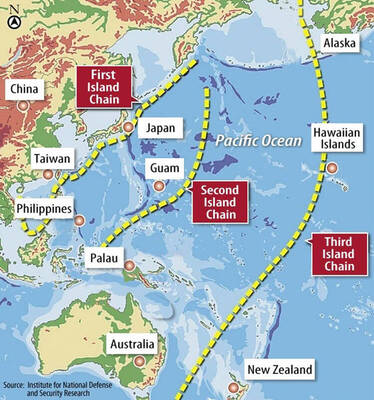China could soon test a new anti-satellite weapon that could pose a threat to Taiwan’s defense capabilities, a US media report said.
According to US intelligence sources, the Dong Ning-2 anti-satellite missile — potentially able to destroy satellites in high-Earth or geosynchronous orbit — will be ready for testing next month.
If it proves successful, the missile could knock out the US satellites that would provide early warning of an attack on Taiwan and other satellites used to conduct defense operations.
The Washington Free Beacon, a politically conservative Web site, reported on Tuesday that tests were being delayed “to avoid upsetting” US President Barack Obama’s re-election bid.
“China’s delay in conducting the test until after the Nov. 6 election is a sign Beijing wants to help Obama’s re-election campaign — it means they’d rather have him re-elected,” a US official familiar with the intelligence reports was quoted as saying.
Intelligence and military sources reached by the Taipei Times on Tuesday refused to confirm or deny the reported anti-satellite development.
“The missile is described by intelligence agencies as a high-earth orbit interceptor designed to destroy satellites by ramming them at high speeds,” the report said.
China has been building an anti-satellite capability for more than 10 years, but testing a high-earth orbit anti-satellite missile would represent a “major advance.”
Military communication and navigation satellites fly at high-earth orbits of 19,300km to 35,410km from Earth.
It is not known how the test will be conducted.
“Defense officials have said that with as few as 24 anti-satellite missiles, China could severely weaken US military operations by disrupting global communications and military logistics as well as by limiting celestial navigation systems used by high-technology weapons,” the report said.
A Department of State-Pentagon report to Congress earlier this year said that Chinese anti-satellite weapons had “significant implications” for anti-access and area-denial efforts against the US in Taiwan Strait contingencies.
It said the weapons were being developed to force the US military out of Asian waters and make it more difficult for US forces to get into the region to defend Taiwan.

The US government has signed defense cooperation agreements with Japan and the Philippines to boost the deterrence capabilities of countries in the first island chain, a report by the National Security Bureau (NSB) showed. The main countries on the first island chain include the two nations and Taiwan. The bureau is to present the report at a meeting of the legislature’s Foreign Affairs and National Defense Committee tomorrow. The US military has deployed Typhon missile systems to Japan’s Yamaguchi Prefecture and Zambales province in the Philippines during their joint military exercises. It has also installed NMESIS anti-ship systems in Japan’s Okinawa

‘WIN-WIN’: The Philippines, and central and eastern European countries are important potential drone cooperation partners, Minister of Foreign Affairs Lin Chia-lung said Minister of Foreign Affairs Lin Chia-lung (林佳龍) in an interview published yesterday confirmed that there are joint ventures between Taiwan and Poland in the drone industry. Lin made the remark in an exclusive interview with the Chinese-language Liberty Times (the Taipei Times’ sister paper). The government-backed Taiwan Excellence Drone International Business Opportunities Alliance and the Polish Chamber of Unmanned Systems on Wednesday last week signed a memorandum of understanding in Poland to develop a “non-China” supply chain for drones and work together on key technologies. Asked if Taiwan prioritized Poland among central and eastern European countries in drone collaboration, Lin

BACK TO WORK? Prosecutors said they are considering filing an appeal, while the Hsinchu City Government said it has applied for Ann Kao’s reinstatement as mayor The High Court yesterday found suspended Hsinchu mayor Ann Kao (高虹安) not guilty of embezzling assistant fees, reducing her sentence to six months in prison commutable to a fine from seven years and four months. The verdict acquitted Kao of the corruption charge, but found her guilty of causing a public official to commit document forgery. The High Prosecutors’ Office said it is reviewing the ruling and considering whether to file an appeal. The Taipei District Court in July last year sentenced Kao to seven years and four months in prison, along with a four-year deprivation of civil rights, for contravening the Anti-Corruption

NO CONFIDENCE MOTION? The premier said that being toppled by the legislature for defending the Constitution would be a democratic badge of honor for him Premier Cho Jung-tai (卓榮泰) yesterday announced that the Cabinet would not countersign the amendments to the local revenue-sharing law passed by the Legislative Yuan last month. Cho said the decision not to countersign the amendments to the Act Governing the Allocation of Government Revenues and Expenditures (財政收支劃分法) was made in accordance with the Constitution. “The decision aims to safeguard our Constitution,” he said. The Constitution stipulates the president shall, in accordance with law, promulgate laws and issue mandates with the countersignature of the head of the Executive Yuan, or with the countersignatures of both the head of the Executive Yuan and ministers or